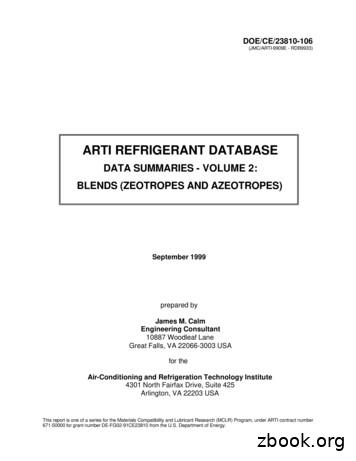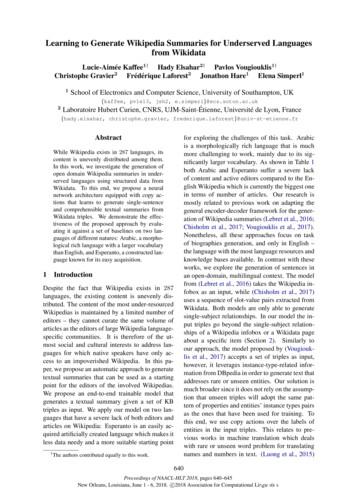How To Write Executive Summaries
How to WriteExecutive SummariesYour Words Matter seriesBetsy DuWaldt, businesswriter@uakron.eduThe University of AkronCollege of Business AdministrationAbout the Author and the DocumentThis document has been developed as part of a series of professional development resourcesfor students at the College of Business Administration by a staff member who has almost 20years of corporate experience. These materials are reviewed by corporate executives and othersas we work to provide helpful information now, as students prepare for careers.
How to WriteExecutive SummariesWriting Executive SummariesExecutive summariesare written so readersunderstand the mainpoints and conclusions oflonger reports.It’s true when people say we live in an information age. Never beforehas so much been written and published. Numerous reports, longarticles, white papers, and other documents are produced every day.If a person decided to read all the materials produced for a particular category or industry, there would be little time left in the day formuch else. To help with this issue, many longer and more complexdocuments have executive summaries associated, which provideconcise overviews of the longer works.Business reports and other, longer documents often offer recommendations based on analyses. By reading executive summaries,organizational decision-makers and other busy people can read recommended actions that typically are part of a report and absorb themain points supporting the recommendations. It also is a documentthat allows readers to decide if they want to read certain sections orthe entire report.As a business student, you should be familiar with the purposeof and how to write executive summaries. While there are no setrules about how to write one because documents and reports varyso much, there are certain essential aspects to which writers shouldadhere.1
Effective Executive SummariesExecutive summaries are meant to summarize main points of areport or other type of document, including the recommendationsand crucial data supporting the recommendations. The executivesummary must provide enough information for the reader to understand why the report or document was produced and the significantconclusions in it. While brevity and conciseness are keys, it’s alsoessential to provide the evidence/information from the report thatsupports the conclusions/recommendations, etc., so readers can follow the path to the conclusions. Executive summaries should alwaysbe written after a report is completed, and never introduce newinformation in the executive summary.AudienceExecutive reports are writtenfor a primary audience ofexecutives; but you still willneed to briefly define termsand concepts.Assume your primary audience is executive level employees, evenif we know people at other levels will be reading your executivesummary. The key for the primary audience is to have all thesalient points of the report presented concisely so you provide anaccurate representation of the report content and recommendations. You’ll still need to briefly define special terms and conceptsfrom the report.Parts of the Executive SummaryReports should be well-written enough to have each section buildto the conclusion. Remember, you are trying to help someone understand the most important points of the document, so determinewhat should and shouldn’t be included based on that. In theory,every section is important, but not every section has the mostcrucial information that bears on the report’sconclusions/recommendations.Sections of an executive summary should generally reflect themajor sections of the document or report with which it’s associated.For example, it’s crucial to include a methodology section whenthe report has a methodology that underlies the report’s analysis.Summarize the key finding in a “Findings” section if the report hasone. Provide a concise description of the solution to the problemand why, which often is followed by specific recommendations. Yourexecutive summary should mirror the main headings and providesynopses of the main points. However, while primary sections alsooften have subsections, you will need to use our judgment on whatto include.Main Idea (Thesis)Any well-written document is about a central idea. Make sure youidentify the main idea, often called the thesis, and capture it in onethree sentences.2
PurposeMake sure you clearlyidentify the purpose of thelonger report in yourexecutive summary.Lengthy documents are written for a reason. It could be a businessplan, an analysis of the risks a disruptive technology presents toa business with some recommended actions, or a report about agovernment program that helps increase literacy, or a class project. Ifyou are responsible for writing the executive summary, identify whya report was written and summarize it in one-three sentences.MethodologyInclude information fromsections that directly lead toreport conclusions/recommendations.The reader needs to know what information was collected and howit was analyzed to understand on the basis of the recommendations.Provide the bases of the methodology and how it’s been applied tothe issue.ToneSome believe the executive summary should be written from a firstperson plural (we, us) perspective, and others believe it should bewritten more formally (referring to “the company,” etc.). The tonewill depend on the audience and how the document will be used. Ifthe document is published to a Website, it might be best to write itmore formally. If it is a short executive summary for an internal document, you can use “we.”LengthAs with other aspects of executive summaries, guidelines on lengthvary. Your executive summary should be at most 10 percent of thefinal document. Therefore, a 10-page white paper would have a1-page executive summary; a 100-page report should have a 10-pageexecutive summary, and so forth.Take-awaysThis document provides some basic guidelines for how to writeexecutive summaries. Please note that organizations and industriesoften have specific guidelines for writing executive summaries. Justremember that you need to produce concise summaries of the crucial aspects of the document so a person can read only the executivesummary and understand the longer report.ResourcesSample Executive Summaries}} Executive Summary for the Report of the Working Group onExpanding Access to Published Research Findings}} 9/11 Commission Report Executive Summary}} Executive Summary for the World of Work Report 2013 Repairing the economic and social fabric report3
Online Resources for Writing Executive Summaries}} Texas A&M Writing Center}} Colorado State University}} Executive Summaries for Business Plans}} University of Maryland University College}} Abstracts and Executive Summaries: Purdue OnlineWriting LabThe University of Akron’s Communication ResourcesSpringboard site:}} Navigating Corporate America}} How to Create Effective Explanations}} How to Peer Edit}} How to Avoid Plagiarism}} Write Emails the Right Way – tutorial}} It’s All Greek to Me – tutorial}} Ingredients for Great Presentations –tutorial}} PowerPoint Design Basics – tutorial}} Common Presentation Mistakes to Avoid – tutorial}} Presenting Numbers – tutorial}} Presentation Introductions and Conclusions – tutorialIf you do not have access to the Springboard Communication Resources site, send your student identification number, your fullname, and your email address to Betsy DuWaldt, BusinessPractitioner – Communications. n4
vary. Your executive summary should be at most 10 percent of the final document. Therefore, a 10-page white paper would have a 1-page executive summary; a 100-page report should have a 10-page executive summary, and so forth. Take-aways This document provides some basic guidelin
Appendix B: Summaries for Geotechnical Manual for Slopes (2nd Edition) 43 Appendix C: Summaries for Geoguide 1 (2nd Edition): Guide to Retaining 60 Wall Design Appendix D: Summaries for Geoguide 2: Guide to Site Investigation 72 Appendix E: Summaries for Geoguide 3: Guide to Rock and Soil 106 Descriptions
Chin-Yew Lin, Workshop on Text Summarization Branches Out, Barcelona, Spain, July 25 - 26, 2004 ROUGE: A Package for Automatic Evaluation of Summaries Chin-Yew Lin . (2002) , and 400 (2001) words summaries -Short summaries of about 100 words in three different tasks in 2003 »focused by an event (30 TDT clusters) . Number of .
Search at ww.osha.gov Fatality and Cat astrophe Investigation Summaries Fatality and Catastrophe Investigation Summaries, also known as Accident Investigation Summaries (OSHA 170 form), are developed after OSHA conducts an inspection in response to a fatality or catastrophe. The summaries provide a complete description of the incident, generally
work/products (Beading, Candles, Carving, Food Products, Soap, Weaving, etc.) ⃝I understand that if my work contains Indigenous visual representation that it is a reflection of the Indigenous culture of my native region. ⃝To the best of my knowledge, my work/products fall within Craft Council standards and expectations with respect to
Think and Grow Rich Page 2 SUCCESS.com SUCCESS BOOK SUMMARIES Page 3 SUCCESS.com SUCCESS BOOK SUMMARIES Page 4 SUCCESS.com SUCCESS BOOK SUMMARIES The Value of Faith FAITH is the “eternal elixir” which gives life, power, and action to the impu
This report provides data summaries from the ARTI Refrigerant Database. Volumes 1 and 2 present refrigerant profiles for single-compound refrigerants and refrigerant profiles, respec-tively. Volume 3 presents data summaries for compatibility and toxicity. They are part of a se-ries to provide a record of the database entries in printed form .
summaries in Esperanto and Arabic respectively for target vocabulary of the textual summaries. Using a larger size of target dictionary in Arabic is due to its greater linguistic variability Arabic vocabulary is 47% larger than Esperanto vocab-ulary (cf. Table1). We replaced any rare enti-1 Torchis a scientic computing package for Lua. It is
Everyone Communicates, Few Connect Everyone Communicates, Few Connect Page 2 SUCCESS.com SUCCESS BOOK SUMMARIES Page 3 SUCCESS.com SUCCESS BOOK SUMMARIES Page 4 SUCCESS.com SUCCESS BOOK SUMMARIES Connecting with others is like anything else in life: You have to be intentional about it. Many people get lazy when it comes to






















